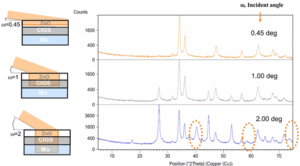
This project centered on the application and theoretical foundations of Grazing Incidence X-ray Diffraction (GI-XD), an advanced material characterization technique designed to analyze thin films, multilayer coatings, and nanostructured surfaces. Unlike traditional XRD, which probes the bulk structure of materials, GI-XD operates at very low incident angles (typically below 1°), allowing X-rays to interact only with the top few nanometers of the surface. This shallow penetration generates evanescent waves that carry highly surface-sensitive information — making GI-XD a vital tool for studying thin films, semiconductors, and corrosion-resistant coatings.
From a methodological standpoint, the project investigated the experimental setup, data acquisition, and analytical modeling necessary for precise GI-XD measurements. Key parameters such as the incident angle (θ), penetration depth (d), and scattering vector (q) were optimized to achieve accurate diffraction patterns. Data processing involved background noise removal, peak modeling through Gaussian and Lorentzian functions, and crystallite size estimation using the Scherrer equation. The study also discussed the Equi-Penetration GIXD (EP-GIXD) technique, which maintains constant penetration depth across diffraction peaks, enabling more accurate stress profiling and structural mapping in multilayer coatings.
The results emphasized GI-XD’s critical role as a non-destructive and high-resolution technique for probing surface stresses, interfacial defects, and nanocrystalline structures. Compared with conventional XRD, GI-XD offers unparalleled sensitivity to nanoscale surface variations, providing insights essential for advancing semiconductor technology, thin-film engineering, and nanomaterials research. Despite challenges such as surface roughness effects and limited penetration depth, GI-XD continues to evolve as a cornerstone in materials science for correlating surface structure with functional performance.